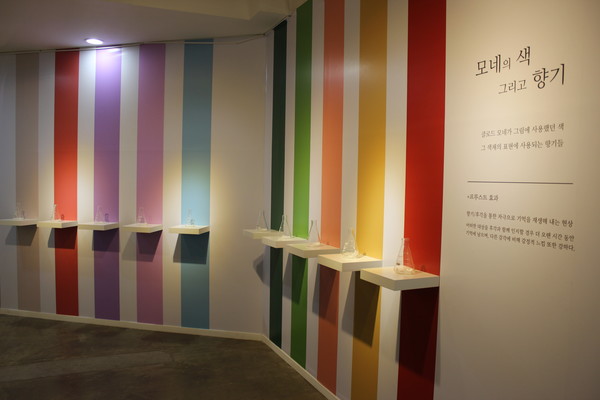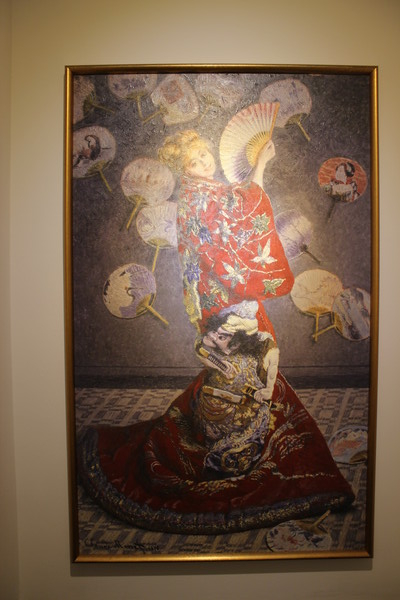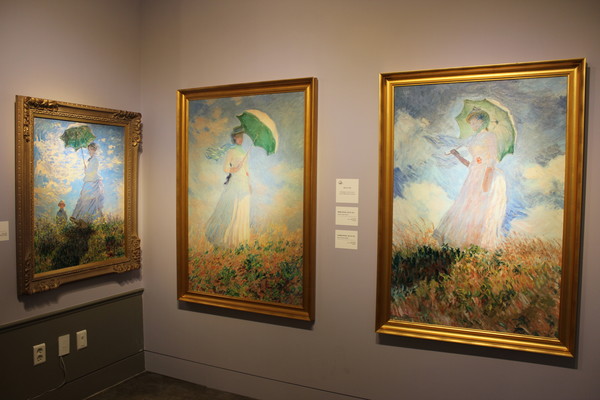The aroma of Monet’s life

IMPRESSION SUNRISE, La Grenouillère, The Artist’s Garden at Giverny are some of Oscar-Claude Monet’s most celebrated pieces, known for their gentle and immersive depictions of seasonal atmospheres. Monet was a French painter who began impressionism, a 19th-century artistic movement typified by delicate brushstrokes that emphasized the ever-changing qualities of light, atmosphere, and landscape. Claude Monet, Meets The Scent encompasses a trend of mixed sensory experiences such as sight and smell. Monet began his career under Eugène Boudin’s mentorship—Boudin taught him to look for natural elements within the sea and forest, which was often reflected in his works. Claude Monet, Meets The Scent allows viewers to revisit Monet’s artworks through scent—eight of his pieces are introduced with complementary olfactory elements of scented paper strips fulfilling the tone of each work.
Monet’s colors and aromatic traces
Prior to entering the gallery, the perfumers provide you with a collection of 8 paper strips—indicative of the main works of Monet which have been doused in the respective fragrances that allude to the atmosphere of each picture. The intended effect of handing out these strips is the Proust effect, a phenomenon in which memories are reproduced by stimulation through scents. There are four large groups of artworks within the exhibition—Monet’s Camille Doncieux, Argenteuil, Camille’s passing, and Giverny Garden.

Camille Doncieux
An underlying theme of the paintings in the exhibition is Monet’s love towards his beloved wife, Camille Doncieux, who was only 18 at the time. It was love at first sight. The first section of the exhibit is dedicated to Camille and contains works such as Camille with a Small Dog and The Cradle – Camille with the Artist’s Son Jean.
The period during which Monet painted Camille in Japanese Costume was when Japonisme [1] had reached its peak in western culture. Camille stands in the middle of a dark room in a loud red kimono surrounded by Japanese fans. The deliberate choice of representing Camille as a blonde poses an interesting dichotomy between the west and the east. The dim background with a vivid touch of silk will remind you of a rich woody oriental note, combined with a strong yet graceful floral scent, owing to Camille’s feminine posture. The designated aroma for Camille in Japanese Costume was rose, cedarwood, and rosewood, which fittingly represents the sensual feminine magnetism of the painting.

Argenteuil
After the Franco-Prussian war in 1871, Monet and his family moved to Argenteuil—a small city located on the banks of the Seine river. Monet’s works during his stay at Argenteuil involve soft color schemes and blissful portrayals of his beloved wife and son, reflective of the tranquil atmosphere by the riverbed.
Spring by the Seine is representative of Monet’s Argenteuil collection; unlike his previous works, Monet includes all aspects of nature—ranging from the sky, water, and earth—in this depiction of a fine spring afternoon. Monet’s crisp and serene portrayal of the scenery goes hand in hand with the fruity and floral blend of apricot, lily, and white musk, carefully selected by the perfumers behind this exhibition.
The next painting in Monet’s Argenteuil collection is The Saint-Lazare Station. This work carries a different tone compared to the rest of the paintings in the segment. It depicts Monet’s departure from his Argenteuil sanctuary and return to Paris. It was a return to his life in the city, away from the peace of living in the countryside. This change in Monet’s environment is immediately echoed in his style of art—instead of illustrating sceneries in nature, he included industrial structures such as train stations and railroads in his painting. The perfumers of the exhibition selected bergamot, cedarwood, and amber to portray this urban atmosphere. The gray exhaust that fills the train station is accurately represented by the smoky scent of cedarwood—its ashy undertone reminds the viewers of the murky industrial atmosphere. The sweet tang of bergamot and the warmth of patchouli, however, forms a stark contrast against the musky notes of cedarwood; this illustrates the dichotomy between the blissful nostalgia of Monet’s last moments spent in Argenteuil and the cold, vacant mood of his new life in Paris’ metropolitan environment.
Woman with a Parasol
Monet rarely painted portraits after Camille’s death due to sorrow and heartache. However, he began painting landscapes with figures again in 1886—Woman with a Parasol was the first work he drew after such a decision. The woman in the painting represents the idea of Camille, the deceased wife and muse of Monet. As can be seen by the woman’s face covered in a veil and her figure fading into the landscape, we are able to realize that the entire painting, in fact, is a visual depiction of Monet’s evanescing memory of his late wife, Camille. Monet’s depiction of the figure in this painting is almost celestial and ghostly, which represents how Camille is remembered by Monet. The fragrances used for this painting correspond to this sentiment, as violet, white rose, and white musk create a pure, soft, and comforting sensation within the viewers. This displays Monet’s memory of Camille as being kind and innocent, like a woman in white.

Giverny Garden
By 1890, Monet had gained wealth and fame as a painter, which led him to purchase a house in Giverny to decorate as a studio. During his stay in Giverny, Monet devoted his time to creating works that illustrated the beautiful water lily pond in his garden. In 1899, he composed the iconic Water Lily Pond, which is reflective of the Japonisme movement in that the painting depicts the reservoir along with an overarching Japanese-style bridge. In 1915, Monet began painting one of his largest artworks, Water Lilies, Green Reflection. The perfumers of the exhibition have selected mandarin, green tea, and aqua to mirror the refreshing and tranquil atmosphere of the pond’s deep cerulean water. Mandarin’s citrusy note and the fresh herbal scent of Green Tea mirrors the refreshing sensation of relaxation Monet felt while spending the last moments of his life at Giverny. The predominant note of Aqua reminds the viewers of fresh breezes and endless oceans, adding to the atmosphere created by Mandarin and Green Tea. The fragrances blend effortlessly with the cool-toned pigments of Monet’s piece, creating a sense of refreshing calmness of the pond’s undisturbed waters.

* * *
Walking through the walls of paintings at Claude Monet, Meets The Scent teaches us the beauty of fragrances and how an additional touch of scent can add a deeper layer to our perception of an art piece. The exhibition offers a final stopover as visitors are given a chance to create their own fragrant artwork inspired by what they have observed. Visitors can choose to make their own perfumes or diffusers based on their desired artwork-fragrance combination. If you wish, you can even add extra scents to add a personal touch and make a one-of-a-kind fragrance. At Claude Monet, Meets The Scent, visitors discover the art of scent in their everyday surroundings.
[1] The influence of Japanese art and design in western Europe in the 19th century following the forced reopening of trade of Japan in 1858.
Period: 2021. 02. 27 – 2021. 05. 30 (closes on Mondays of each month)
Hours: 10:00 – 19:00 (last entry: 18:00 p.m.)
Admission fee: Adults (above 14) ₩6,000 / Children (below 13) ₩5,000
Location: Heylis Gallery (Gyeonggi-do Paju-si, Tanhyeon-myeon, Heyri Art Village Road 7)

